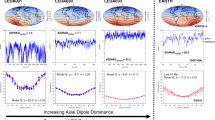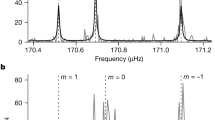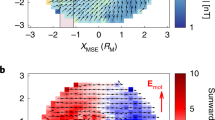Abstract
SINCE the landing of the first Luna spacecraft it has been known that the present magnetic moment of the Moon is negligible. Later, the Explorer 35 data1 gave an upper limit of 4 γ (= 4 nT) to the dipole field at the surface. Now, Russell et al.2 by analysing the Apollo 15 subsatellite magnetometer data obtained during passages of the Moon through the geomagnetic tail (where the magnetic field is reasonably steady) have calculated an upper limit of 0.05 γ. They have shown that both the induced and the permanent magnetic dipole moments can be determined by separately analysing data obtained during passages of the Moon through the north and south lobes of the tail, in which the field is directed towards and away from the Sun, respectively. Only the permanent dipole component in the plane of the subsatellite orbit is determinable and is less than 1.3 × 1018 gauss cm3: it is unlikely that the component perpendicular to it is appreciably greater. Russell et al.2 estimated the error to be 1.33 × 1018 gauss cm3, and therefore concluded that the lunar magnetic moment is not significantly different from zero. Paradoxical as it may seem, it follows from this observation that the Moon possessed a magnetic field of internal origin in its early history.
This is a preview of subscription content, access via your institution
Access options
Subscribe to this journal
Receive 51 print issues and online access
$199.00 per year
only $3.90 per issue
Buy this article
- Purchase on SpringerLink
- Instant access to full article PDF
Prices may be subject to local taxes which are calculated during checkout
Similar content being viewed by others
References
Sonett, C. P., Colburn, D. S., and Currie, R. G., J. geophys. Res., 72, 5503–5507 (1967).
Russell, C. T., Coleman, P. J., and Schubert, G., Science, 186, 825–826 (1974).
Runcorn, S. K., et al., Geochim. cosmochim. Acta, suppl. 1, 3, 2369–2387 (1970).
Runcorn, S. K., Proc. R. Soc., A 296, 270–284 (1967).
Runcorn, S. K., et al., Proc. R. Soc., A 325, 157–174 (1971).
Runcorn, S. K., and Urey, H. C., Science, 180, 636 (1973).
Stephenson, A., Collinson, D. W., and Runcorn, S. K., Geochim. cosmochim. Acta, suppl. 5, 3, 2859–2871 (1974); Collinson, D. W., Stephenson, A., and Runcorn, S. K., Geochim. cosmochim. Acta, suppl. 4, 3, 2963–2976 (1973).
Runcorn, S. K., Phys. Earth planet. Interiors (in the press).
Hide, R., The Moon, 4, 39 (1972).
Fuller, M., Rev. Geophys. Space Phys., 12, 23–70 (1974).
Russell, C. T., Coleman, P. J., Lichtenstein, B. R., Schubert, G., and Sharp, L. R., Geochim. cosmochim. Acta, suppl. 4, 3, 2833–2845 (1973).
Mihalov, J. D., Sonett, C. P., Binsack, J. H., and Moutsoulas, M. D., Science, 171, 829–895 (1971).
Collinson, D. W., Runcorn, S. K., Stephenson, A., and Manson, A. J., Geochim. cosmochim. Acta, suppl. 3, 3, 2343–2361 (1972).
Russell, C. T., Coleman, P. J., Lichtenstein, B. R., and Schubert, G., Geochim. cosmochim. Acta, suppl. 5, 3, 2747–2760 (1974).
Author information
Authors and Affiliations
Rights and permissions
About this article
Cite this article
RUNCORN, S. An ancient lunar magnetic dipole field. Nature 253, 701–703 (1975). https://doi.org/10.1038/253701a0
Received:
Revised:
Published:
Issue Date:
DOI: https://doi.org/10.1038/253701a0
This article is cited by
-
Thermal Evolution and Magnetic Field Generation in Terrestrial Planets and Satellites
Space Science Reviews (2010)
-
Interior Evolution of Mercury
Space Science Reviews (2007)
-
MESSENGER Mission Overview
Space Science Reviews (2007)
Comments
By submitting a comment you agree to abide by our Terms and Community Guidelines. If you find something abusive or that does not comply with our terms or guidelines please flag it as inappropriate.



